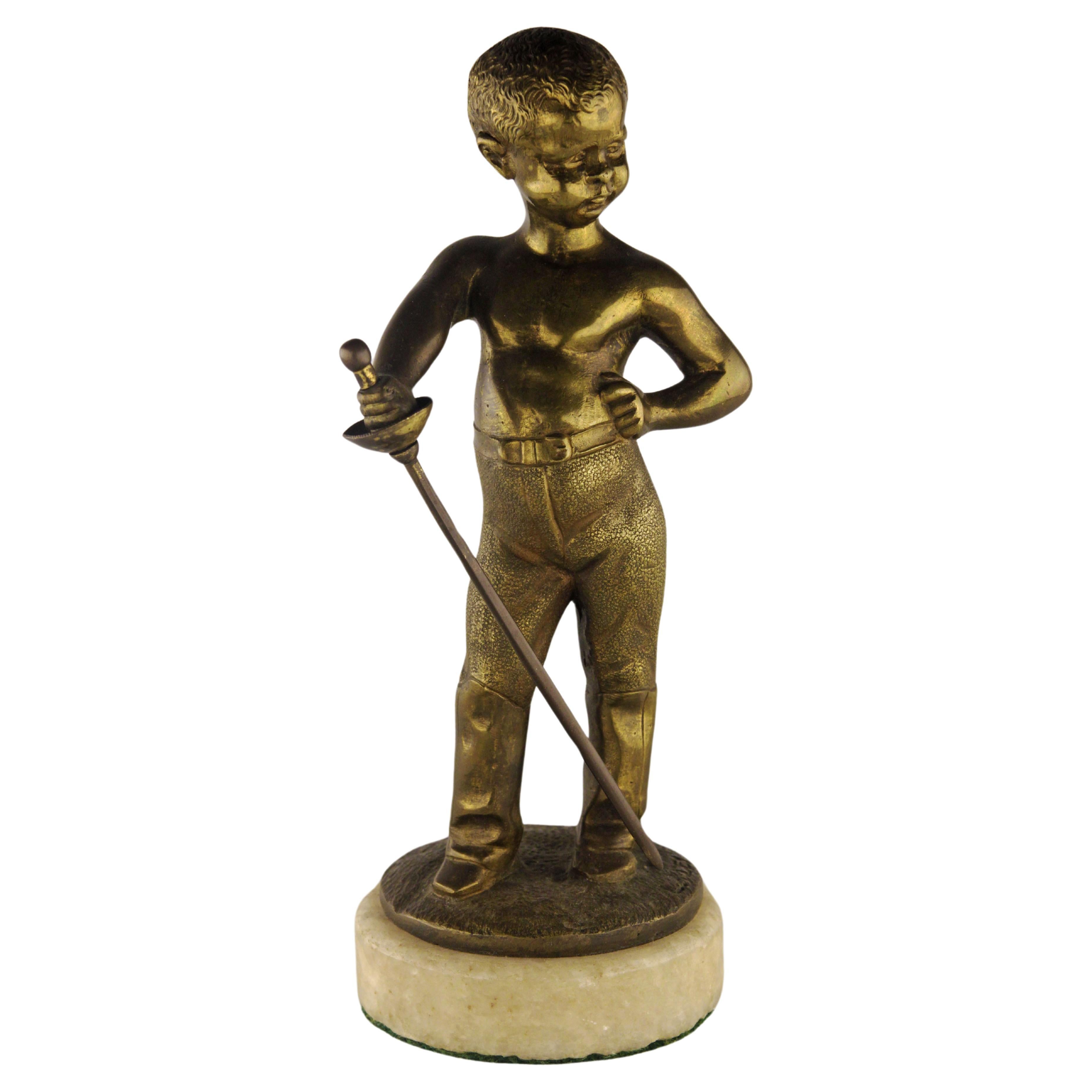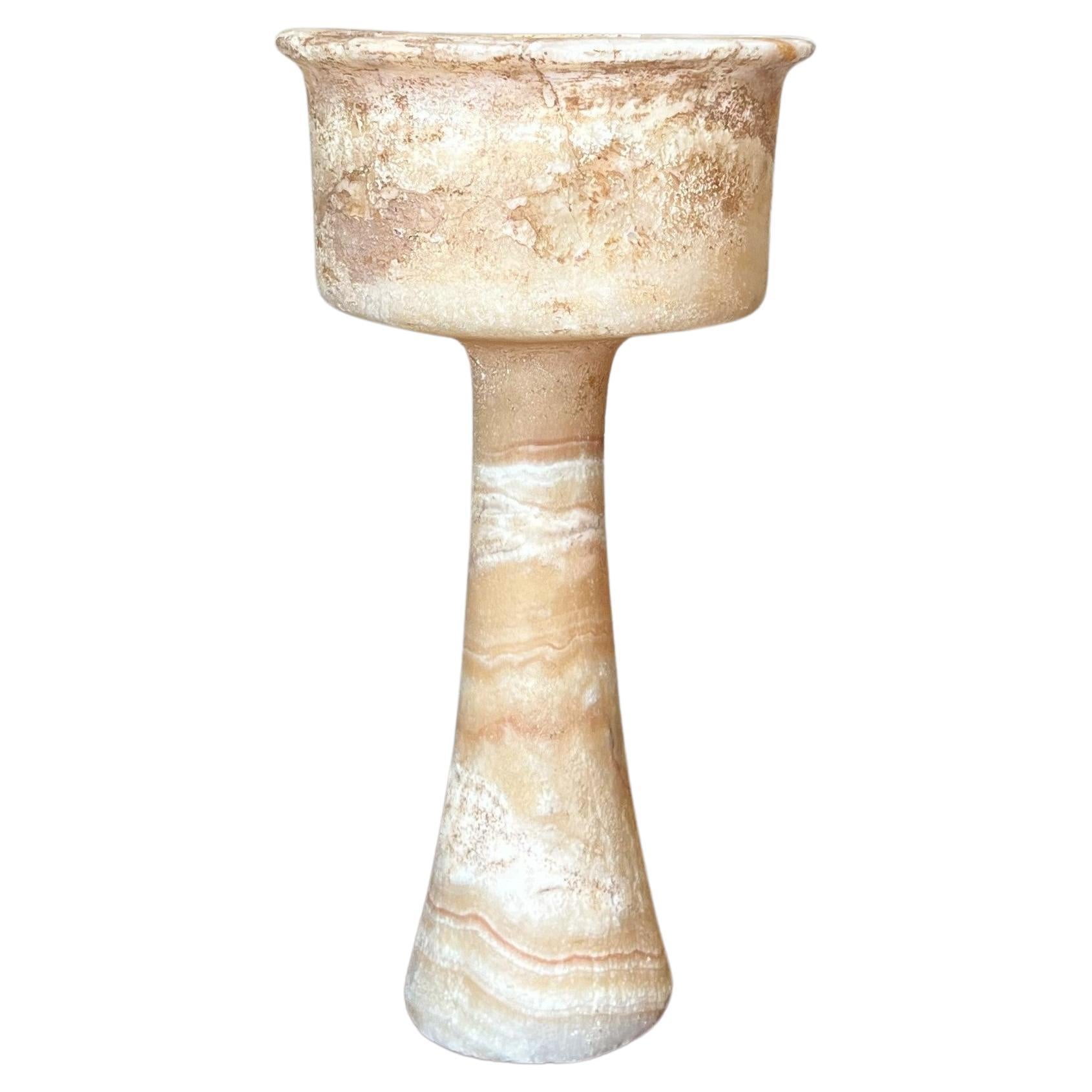Want more images or videos?
Request additional images or videos from the seller
1 of 8
Late Bronze Age Sword
About the Item
Saint Nazaire Sword, Late Bronze Age, circa 800-900 B.C.
An exceptionally well preserved Bronze Age sword, with elegant, finely incised decorations, near perfect form and a wonderful, golden patina. Subtly leaf shaped and tapering to a fine point, this handsome bronze weapon is characteristic of an Atlantic sword of the Saint-Nazaire type. It has a tripartite flanged hilt, with straight horns and seven piercings for rivets to fasten a handle, five of which are still present. Five finely incised lines run from the notched ricasso along and around the raised midrib. The Saint-Nazaire type represents a transitional phase between the leaf-shaped and the so-called carp’s tongue swords of the Atlantic coastal areas of France in the Late Bronze Age.
This sword was most likely recovered from the bed of the River Saône, near Lyon, France, as suggested by the inscription “Saône-Près-Lyon” on the side of the hilt. The recovery of swords in rivers is a strong reminder of their past spiritual significance; the cult of the waters was particularly prominent during the Bronze Age, and it is highly probable that the present sword was deposited as a ritual offering to the river in which it was recovered, millennia later. The River Saône in particular is a very rich ground for the discovery of Bronze Age artefacts, and notably of Late Bronze Age swords. The retrieval of several Atlantic swords in the Saône, such as the present example, illustrates the numerous contacts and exchanges which must have taken place between the Atlantic and Continental cultural complexes at the time.
The development of bronze smithing in Europe coincided with the emergence of a new warrior elite, known to us from their elaborate burials, presiding over a network of competing chiefdoms. These masterfully crafted swords served to demonstrate their rank, and illustrate to us that this was a profoundly warlike culture, in which combat ability was highly prized. Indeed, recent studies, investigating the use-wear on weapons such as this, and what this can tell us about how those who wielded them fought, seem to suggest that Bronze Age swordsmanship was a carefully studied discipline, and that warriors of the period were a dedicated and highly trained class within their contemporary society.
“The weapons of the bronze age, the beauty of which arrests the attention of the most careless observer . stamps the ancient bronze workers not only as skilled mechanics, but as art work- men.”
Robert Day, Ulster journal of Archeology (1895)
Length: 71 cm (28 inches).
Provenance:
Recovered from the River Saône, near Lyon [according to a handwritten inscription on the hilt].
Collection of Monsieur F. B. (1950-2009), Normandy, France.
Subsequently French art market 2021 and exported under French Cultural Property Passport 233626.
- Dimensions:Height: 27.96 in (71 cm)Diameter: 2.37 in (6 cm)
- Materials and Techniques:
- Place of Origin:
- Period:
- Date of Manufacture:800 - 900 BC
- Condition:
- Seller Location:London, GB
- Reference Number:1stDibs: LU1052234448392
About the Seller
5.0
Recognized Seller
These prestigious sellers are industry leaders and represent the highest echelon for item quality and design.
Established in 2008
1stDibs seller since 2014
100 sales on 1stDibs
Typical response time: 7 hours
Associations
LAPADA - The Association of Arts & Antiques DealersInternational Confederation of Art and Antique Dealers' AssociationsThe British Antique Dealers' Association
- ShippingRetrieving quote...Ships From: London, United Kingdom
- Return PolicyA return for this item may be initiated within 14 days of delivery.
More From This SellerView All
- Bronze Age Cypriot Plank IdolLocated in London, GBCypriot Plank Idol Early Bronze Age III - Middle Bronze Age I, c. 2100 - 1850 BC. Low fired burnished earthenware pottery with lime-filled incisions A Cypriot plank idol, an iconic form of human representation from Bronze Age Cyprus...Category
Antique 15th Century and Earlier Cypriot Abstract Sculptures
MaterialsTerracotta
- Etruscan Bronze Statuette of Discus ThrowerLocated in London, GBA remarkably fine example of Archaic sculpture. A figure of a discophoros, or discus bearer, standing with his right leg forward, gripping a discus in his right hand, the left arm raised with an open palm. Described with admiration in Münzen und Medaillen's 1961 auction, "The figure is a masterpiece and illustrates with rare vividness the essence of good Etruscan sculpture...Category
Antique 15th Century and Earlier Figurative Sculptures
MaterialsBronze
- Ancient Greek Hellenistic Bronze Statuette of SatyrLocated in London, GBBeautifully cast statuette of a satyr, Greek, Hellenistic Period, 3rd-2nd Century BC, solid cast bronze The present work is a wonderful example of the finest Hellenistic style. The ...Category
Antique 15th Century and Earlier Greek Classical Greek Figurative Sculpt...
MaterialsBronze
- Natural Gogotte FormationLocated in London, GB'Louis XIV' Gogotte Formation Measures: circa 30 Million y/o 105 x 76 x 15 cm A magnificent example of a gogotte formation, nicknamed Louis XIV, composed of thick swirls and folds of sparkling sandstone. Discovered in the Oligocene sand dunes of Fontainebleau, France, formed circa 30 million years before present or later. The incredible, almost otherworldly appearance of gogottes may easily be mistaken for the work of a most talented artist. In fact, these sandstone sculptures are entirely natural in origin. They have been found in multiple locations but those from Fontainebleau, such as the present example, are the most remarkable. Thirty-five million years ago, a sea covered what is now the forest of Fontainebleau, and dunes of exceptionally fine and homogenous sand formed. As silica-rich water filtered through this sand, it turned into stone. The flow of water finely modelled the sandstone into the forms we now know as gogottes. These are rare and are only found sporadically, several metres buried underground. They owe their sparkling white appearance to the extreme and unmatched purity of the Fontainebleau sand, sometimes reaching a composition of 99.9% silica. Each of them is unique – a masterpiece slowly fashioned by the hands of Nature. The name “gogotte” was coined by French geologist Claude Guillemin (1923- 1994), inspired by the children’s book series Babar the Elephant...Category
Antique 15th Century and Earlier French Natural Specimens
MaterialsSandstone
- Fossilised Colla Wood Cross-SectionLocated in London, GBFossilised colla wood cross-section Miocene, circa 5-23 Million y/o This fossilised white pine wood section displays a beautiful surface, with vibrant h...Category
Antique 15th Century and Earlier Turkish Natural Specimens
MaterialsStone
- Natural Gogotte FormationLocated in London, GBA magnificent example of a gogotte formation composed of thick swirls and folds of sparkling sandstone. Discovered in the Oligocene sand dunes of Fontainebleau, France, formed circa 30 million years before present or later. The incredible, almost otherworldly appearance of gogottes may easily be mistaken for the work of a most talented artist. In fact, these sandstone sculptures are entirely natural in origin. They have been found in multiple locations but those from Fontainebleau, such as the present example, are the most remarkable. Thirty-five million years ago, a sea covered what is now the forest of Fontainebleau, and dunes of exceptionally fine and homogenous sand formed. As silica-rich water filtered through this sand, it turned into stone. The flow of water finely modelled the sandstone into the aesthetic concretions we now know as gogottes. These are rare and are only found sporadically several metres deep into the ground. They owe their sparkling white appearance to the extreme and unmatched purity of the Fontainebleau sand, sometimes reaching a composition of 99.9% silica. Each of them is unique – a masterpiece slowly fashioned by the hands of Nature. The intriguing name of “gogotte” was coined by French geologist Claude Guillemin (1923- 1994), who was inspired by the children’s book series Babar the Elephant. In one of the books, a group of monsters called Gogottes are shown hiding behind rocks. These rocks reminded Guillemin of the sandstone concretions...Category
Antique 15th Century and Earlier Natural Specimens
MaterialsOther
You May Also Like
- Aged Bronze Bucking BroncosLocated in New York, NYPair of mid century Bucking Bronco horse figures with articulating back leg.Category
Mid-20th Century American American Classical Animal Sculptures
MaterialsBronze
- Aged Bronze Bull Bookends, B. SeibelBy Ben SeibelLocated in New York, NYPair of mid century bronze stylized bull bookends by Ben Seibel for Jenfredware.Category
20th Century American Mid-Century Modern Animal Sculptures
MaterialsBronze
- Late 19th Century French Bronze Sculpture of a Boy with a Sword by Louis KleyBy Louis KleyLocated in North Miami, FLLate 19th century french bronze sculpture of a boy with a sword by Louis Kley By: Louis Kley Material: bronze, alabaster, copper, stone, metal Technique: cast, patinated, molded, me...Category
Antique Late 19th Century French Belle Époque Figurative Sculptures
MaterialsAlabaster, Stone, Bronze, Metal, Copper
- Archaic Jade Bi, Early Bronze AgeLocated in Atlanta, GATranslucent green and brown jade Bi from the early Bronze age. (2200 - 1900 B.C). The organic shapes created by the blending of these two main colors evo...Category
Antique 15th Century and Earlier Chinese Antiquities
MaterialsJade
- Large Bactrian Bronze Age Alabaster ChaliceLocated in Vosselaar, BEBactrian alabaster chalice, circa 3000-2000 BC. It has an elegant tapering formed base with a undeep rimmed cup. The alabaster is strikingly vained. ...Category
Antique 15th Century and Earlier Afghan Archaistic Antiquities
MaterialsAlabaster
- Asia Horse Animal Bronze, Late 19th CenturyAsia Horse Animal Bronze, Late 19th CLocated in Marseille, FRAnimal bronze horse Asia (?). The dimensions are 16 cm high, 23 cm wide and 7 cm deep estimated time late XIX th. Additional information: Material: Bro...Category
Antique Late 19th Century Animal Sculptures
MaterialsBronze
Recently Viewed
View AllMore Ways To Browse
Cobra Fat Medio
Colt 2005 Chandelier
Concetta Mason
Contemporary Porcelain Vase Platinum Sea Fossil Texture
Cubist Terra Cotta Wall Sculpture
Dogon Sculpture Antique
Don Freedman On Sale
Don Riggs
Donna Craven
Doug Delind
Eames Leather L C W
Effe Due Murano
Effe Due
Emma De Sigaldi
Erich Bolinger On Sale
Evert Den Hartog
Extra Large Dan Murphy Abstract
Frances Anderson





